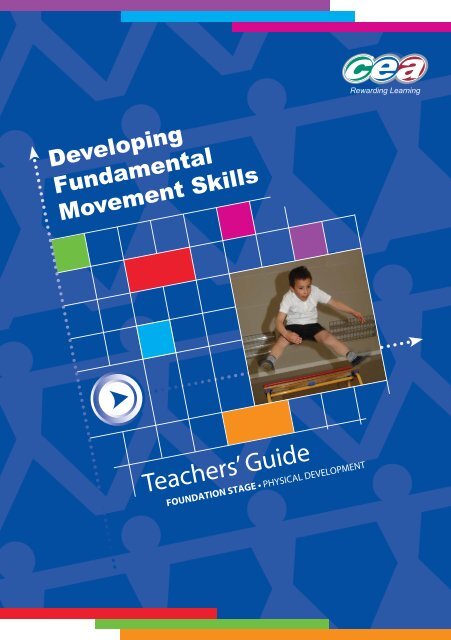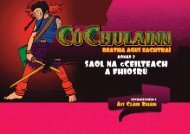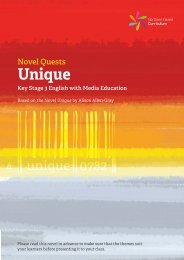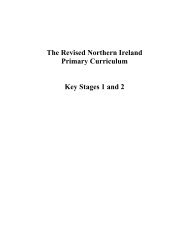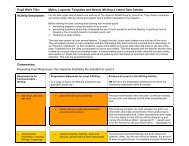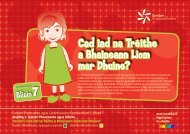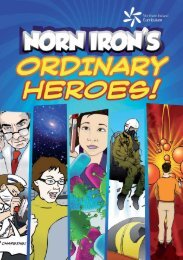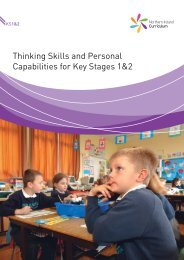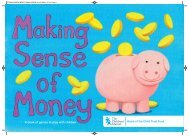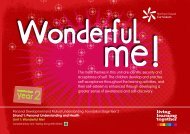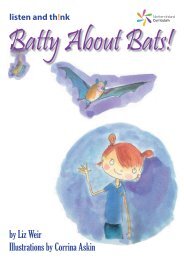Developing Fundamental Movement Skills - Northern Ireland ...
Developing Fundamental Movement Skills - Northern Ireland ...
Developing Fundamental Movement Skills - Northern Ireland ...
Create successful ePaper yourself
Turn your PDF publications into a flip-book with our unique Google optimized e-Paper software.
<strong>Developing</strong><br />
<strong>Fundamental</strong><br />
<strong>Movement</strong> <strong>Skills</strong><br />
Teachers’ Guide<br />
FOUNDATION STAGE PHYSICAL DEVELOPMENT
DEVELOPING FUNDAMENTAL MOVEMENT SKILLS<br />
FOREWORD<br />
The purpose of this resource is to provide teachers and assistants with support<br />
in planning, teaching and assessing Physical Development in the Foundation<br />
Stage. It incorporates the development of children’s <strong>Fundamental</strong> <strong>Movement</strong><br />
<strong>Skills</strong> (FMS). The resource emphasises the importance of connecting children’s<br />
learning and provides examples of how to connect learning across a range of<br />
contexts.<br />
A sample of six <strong>Fundamental</strong> <strong>Movement</strong> <strong>Skills</strong> has been selected. Teachers may<br />
wish to develop their own planning using other FMS relevant to the needs and<br />
interests of their class.<br />
Partnership with the home and local community should be encouraged. By<br />
talking to parents about the skills to be developed and by sending home some<br />
practical activities, parents can help support a child’s learning.<br />
The FMS Resource and professional learning programme was produced by<br />
Steps Professional Development for the Department of Education and Training,<br />
Western Australia.<br />
The programme has been very successfully piloted and evaluated by CCEA, in<br />
conjunction with the fi ve Education and Library Boards in <strong>Northern</strong> <strong>Ireland</strong>. Five<br />
primary schools piloted the programme and a large number of primary school<br />
teachers (approximately 400 to date) have completed the teacher professional<br />
development course.<br />
This resource supports and complements the FMS professional development<br />
training programme. The FMS programme and principles underpin many<br />
aspects of Physical Development/Physical Education within the <strong>Northern</strong> <strong>Ireland</strong><br />
Curriculum.<br />
Alison Thompson<br />
Principal Offi cer<br />
CCEA<br />
FOUNDATION STAGE • PHYSICAL DEVELOPMENT
DEVELOPING FUNDAMENTAL MOVEMENT SKILLS<br />
CONTENTS<br />
Physical Development within the <strong>Northern</strong> <strong>Ireland</strong> Curriculum<br />
page<br />
1<br />
Rationale and Principles 2<br />
Why teach FMS? 3<br />
How should FMS be delivered? 4<br />
Outline of Unit Format 5<br />
Progression within FMS 6<br />
Making Physical Education Inclusive 8<br />
Safety Implications 9<br />
The STEP framework 10<br />
Suggested Resources 12<br />
Acknowledgements 14<br />
FOUNDATION STAGE • PHYSICAL DEVELOPMENT
DEVELOPING FUNDAMENTAL MOVEMENT SKILLS<br />
PHYSICAL DEVELOPMENT WITHIN THE<br />
NORTHERN IRELAND CURRICULUM<br />
Physical Development/Physical Education is one of the six Learning Areas within<br />
the <strong>Northern</strong> <strong>Ireland</strong> Curriculum.<br />
Children enter primary school having had a range of movement experiences<br />
in the home, pre-school setting and the local community. They will have<br />
experienced control, coordination and manipulation of their body, using a range<br />
of equipment and will have some awareness of space.<br />
Physical Development is about experiencing and developing a range of<br />
fundamental movement skills that will improve co-ordination, locomotion,<br />
control, balance, and manipulation.<br />
In addition, physical development helps children gain confi dence and selfesteem.<br />
Through taking part in physical activities, children should begin to<br />
develop an understanding of safe practices, the relationship between physical<br />
activity and good health in everyday life and the importance of changing for<br />
physical activities.<br />
They should develop social skills such as turn-taking, sharing, co-operating and<br />
negotiating, and values such as trust, fairness and respect for others.<br />
Children should have opportunities to take part in daily physical activities, either<br />
indoors or outdoors. These activities should comprise physical play and regular<br />
and frequent planned sessions of physical education.<br />
Play situations provide ideal opportunities for children to create their own<br />
movement sequences and simple games. During these activities, children make<br />
decisions, refi ne performance and improve their movement skills.<br />
The development of the fundamental movement skills needs to be nurtured, not<br />
only because they are important for the child’s long-term health and well-being,<br />
but also because they support the child’s physical development.<br />
Teachers should observe and assess children’s development and use the<br />
information gathered to plan future learning experiences that promote the<br />
development and consolidation of the fundamental movement skills.<br />
The statutory requirements for Physical Development in the Foundation Stage<br />
and Physical Education at Key Stage 1 and 2 can be located on the CCEA website:<br />
www.ccea.org.uk<br />
– 1 –<br />
FOUNDATION STAGE • PHYSICAL DEVELOPMENT
DEVELOPING FUNDAMENTAL MOVEMENT SKILLS<br />
RATIONALE AND PRINCIPLES<br />
What are <strong>Fundamental</strong> <strong>Movement</strong> <strong>Skills</strong>?<br />
“FMS are movement patterns that involve diff erent body parts such as the legs,<br />
arms, trunk and head, and include such skills as running, hopping, catching,<br />
throwing, striking and balancing. They are the foundation movements necessary<br />
for 3–8-year-old children as a precursor to the more specialised, complex skills<br />
used in play, games, sports, dance, gymnastics, outdoor education and physical<br />
recreation activities.”<br />
Ref: FMS Teacher Resource, Education Dept., Western Australia 2004.<br />
Early childhood is the optimal time to teach and learn fundamental movement<br />
skills. During this period young children are motivated and keen to<br />
master ways of moving, controlling their bodies and coordinating their<br />
movements.<br />
THERE ARE 22 FUNDAMENTAL MOVEMENT SKILLS.<br />
THEY ARE DIVIDED INTO 3 CATEGORIES:<br />
BODY MANAGEMENT LOCOMOTOR OBJECT CONTROL<br />
Balance Continuous leap Catch<br />
Climb Dodge Chest pass<br />
Forward roll Gallop Foot dribble<br />
Line walk Hop Hand dribble<br />
Jump for distance Kick<br />
Jump for height Overarm throw<br />
Side gallop Underarm throw<br />
Skip Punt<br />
Sprint run Two-handed strike<br />
Ref: FMS Teacher Resource, Education Dept., Western Australia 2004.<br />
– 2 –<br />
FOUNDATION STAGE • PHYSICAL DEVELOPMENT
DEVELOPING FUNDAMENTAL MOVEMENT SKILLS<br />
WHY TEACH FMS?<br />
Research reveals that children attribute low motor skills as a major barrier to<br />
participation in physical activity and drop out from organised sport because<br />
they can not perform the skills well enough to play the game successfully.<br />
Physical activity provides health benefi ts for children, including:<br />
• Providing important protection from developing coronary heart disease;<br />
• A longer life with better managed weight, lower blood pressure and healthier<br />
cholesterol levels;<br />
• Healthy growth and development of the cardio respiratory system as well as<br />
bones and muscles; and<br />
• Mental and social health benefi ts including feelings of confi dence, happiness<br />
and relaxation as well as an ability to sleep better.<br />
Children who develop confi dence with their FMS skills may enjoy many benefi ts.<br />
Those who have a positive attitude to physical activity may have higher self-<br />
esteem, improved health and well being, good social skills, are more willing to<br />
take risks and are also more likely to maintain an active and healthy lifestyle.<br />
Research reveals that children with low motor skills can be at risk of reduced<br />
self-esteem and choose to avoid physical activity. This may lead to compromised<br />
muscle and bone density, reduced fi tness and fewer opportunities for social<br />
development.<br />
– 3 –<br />
FOUNDATION STAGE • PHYSICAL DEVELOPMENT
DEVELOPING FUNDAMENTAL MOVEMENT SKILLS<br />
HOW SHOULD FMS BE DELIVERED?<br />
For young children, diff erent aspects of the school day off ers opportunities<br />
to develop and use their fundamental movement skills. Structured Physical<br />
Education lessons, along with other planned and incidental experiences and<br />
routines of the day, should provide a range of rich contexts for children to<br />
explore, develop and refi ne their fundamental movement skills.<br />
While each year group should experience and explore a large number of FMS,<br />
it is important that each year focuses on specifi cally teaching and assessing<br />
a small number of skills. This progression of learning, teaching and assessing<br />
the range of skills should be mapped throughout Foundation Stage and Key<br />
Stage 1 and used as a guide for teachers’ planning. It is essential that each teacher<br />
and school plans and delivers relevant learning and teaching experiences that<br />
supports the needs of children within their own class/school.<br />
FMS can and should be reinforced through:<br />
• Teacher led activities;<br />
• Child led activities;<br />
• Learning through play, including outdoor play;<br />
• Playground activities;<br />
• Home-link activities; and<br />
• Community links.<br />
– 4 –<br />
FOUNDATION STAGE • PHYSICAL DEVELOPMENT
DEVELOPING FUNDAMENTAL MOVEMENT SKILLS<br />
OUTLINE OF UNIT FORMAT<br />
There are six units within the resource pack, each one focusing on one<br />
particular FMS:<br />
• Balance;<br />
• Catch;<br />
• Hop;<br />
• Jump for Distance;<br />
• Jump for Height; and<br />
• Sprint Run.<br />
Each unit follows a similar format. The overview leafl et provides:<br />
• A general overview of the focused skill;<br />
• The details of statutory requirements – Key Experiences and Progress in<br />
Learning covered within the unit;<br />
• Ideas for connecting learning across a range of contexts;<br />
• Self-evaluation information to share with the children; and<br />
• Some key vocabulary.<br />
Each unit also provides:<br />
• A sample PE unit of work;<br />
• A cue card, providing teaching points when teaching the skill;<br />
• Additional Activities - teacher and child led learning experiences;<br />
• Rhymes and Action Songs; and<br />
• Home Learning Links.<br />
– 5 –<br />
FOUNDATION STAGE • PHYSICAL DEVELOPMENT
Progression within<br />
<strong>Fundamental</strong> <strong>Movement</strong> <strong>Skills</strong><br />
Generally, skills such as the forward roll and dribble are more diffi cult<br />
than the skills of running and balancing.<br />
By the end of year 4, all children should have been provided with<br />
opportunities to develop the range of FMS skills.<br />
The FMS sequence detailed below provides suggestions on the order<br />
of which to teach the range of FMS. There are three categories, as<br />
developed by the Western Australian model and adopted within<br />
<strong>Northern</strong> <strong>Ireland</strong>. They are: body management, locomotor and<br />
object control.<br />
The sequence below is colour coded to give guidance on those skills<br />
that children should experience, be taught and are continuing to<br />
develop further:<br />
Please note that this is only a sample as used by one of the pilot schools<br />
and remember that all schools and classes are diff erent. The range of<br />
FMS skills are not necessarily developed or acquired in the sequence.<br />
This particular school has a nursery school and this has been taken into<br />
account when planning and providing opportunities.<br />
• Blue... Experience<br />
• Red... Teaching<br />
• Green... Continuing<br />
Exemplar <strong>Fundamental</strong> <strong>Movement</strong> <strong>Skills</strong> Teaching Sequence<br />
From Seagoe Primary School, Portadown
NURSERY YEAR 1 YEAR 2 YEAR 3 YEAR 4<br />
Balance on 1 Foot<br />
Balance on 1 Foot<br />
Balance on 1 Foot<br />
Balance on 1 foot<br />
Balance on 1 foot<br />
Forward Roll<br />
Side Roll<br />
Side Roll<br />
Side Roll<br />
Climb<br />
Climb<br />
Climb<br />
Climb<br />
Climb<br />
BODY<br />
MANAGEMENT<br />
SKILLS<br />
Bench Walk<br />
Bench Walk<br />
Bench Walk<br />
Line Walk<br />
Line Walk<br />
Underarm Throw<br />
Underarm Throw<br />
Underarm Throw<br />
Underarm Throw<br />
Underarm Roll<br />
Overarm Throw<br />
Overarm Throw<br />
Overarm Throw<br />
Overarm Throw<br />
Overarm Throw<br />
Catch Small Ball<br />
Catch Small Ball<br />
Catch medium ball<br />
Catch large ball<br />
Catch large ball<br />
1 Handed Strike<br />
2 Handed Strike<br />
2 Handed Strike<br />
2 Handed Strike<br />
Foot Dribble<br />
Foot Dribble<br />
Foot Dribble<br />
Foot Dribble<br />
Kick<br />
Kick<br />
Kick<br />
Kick<br />
OBJECT<br />
CONTROL<br />
SKILLS<br />
Hand Dribble<br />
Chest Pass<br />
Punt<br />
Sprint Run<br />
Sprint Run<br />
Sprint Run<br />
Sprint Run<br />
Sprint Run<br />
Skip<br />
Skip<br />
Skip<br />
Skip<br />
Skip<br />
Hop<br />
Hop<br />
Hop<br />
Hop<br />
Hop<br />
Gallop<br />
Gallop<br />
Gallop<br />
Gallop<br />
Gallop<br />
Side Gallop<br />
Side Gallop<br />
Side Gallop<br />
Side Gallop<br />
Side Gallop<br />
LOCOMOTOR<br />
SKILLS<br />
Jump for Height<br />
Jump for Height<br />
Jump for Height<br />
Jump for Height<br />
Jump for Height<br />
Jump for Distance<br />
Jump for Distance<br />
Jump for Distance<br />
Dodge<br />
Dodge<br />
Leap (continuous)<br />
DEVELOPING FUNDAMENTAL MOVEMENT SKILLS FOUNDATION STAGE • PHYSICAL DEVELOPMENT
DEVELOPING FUNDAMENTAL MOVEMENT SKILLS<br />
Making Physical Education Inclusive for<br />
Children with Special Educational Needs<br />
It is important not to make generalisations about the physical ability of children<br />
with special educational needs as each individual child will require diff erent<br />
considerations and have diff erent capabilities. In the context of physical activity,<br />
the following points may be useful.<br />
• Do not underestimate the intelligence or ability of children with special<br />
educational needs.<br />
• Talk with them, and involve their parents, carers, the special educational<br />
needs co-ordinator and others to establish what they can do and what their<br />
needs are.<br />
• Explore ways of including rather than reasons for not including. Allow the<br />
children to work together on adapting activities.<br />
• Enable children with special educational needs to succeed and enjoy the<br />
activity.<br />
• It may be appropriate for some children to work on a diff erent activity. Discuss<br />
this openly with the class.<br />
• Some activities are made up of various skills. If the child does not have all<br />
the skills, start from what they can do and build from there.<br />
Children who have other physical or sensory impairments or learning diffi culties<br />
should be encouraged as much as possible to maximise their movement potential<br />
by fully developing their abilities.<br />
‘TOPS’ cards from the Youth Sport Trust<br />
provide suggestions and illustrations<br />
for alternative or adapted forms of the<br />
activities to give appropriate access to<br />
all children.<br />
– 8 –<br />
FOUNDATION STAGE • PHYSICAL DEVELOPMENT
DEVELOPING FUNDAMENTAL MOVEMENT SKILLS<br />
Safety Implications<br />
The following are specifi cally in relation to inclusive activities:<br />
• All participants need to be careful and aware when a wheelchair user is<br />
included in activities. Lines of vision may diff er and additional space within<br />
the area will usually be required.<br />
• Some of the activities may require the use of wheelchair user or ambulant<br />
only zones in order that everyone can participate together in safety.<br />
• Some children will be more vulnerable to physical contact. This can be due to<br />
variations in mobility, balance and reaction time.<br />
• Consider the safety of children who have a sensory impairment. Will they see/<br />
hear the fi re alarm?<br />
• Allow children who have a visual impairment to feel and handle any equipment.<br />
They should also have time to experience the layout of the room.<br />
• Some children may have medical needs that aff ect their participation in<br />
physical activity, eg, tolerance can vary from individual to individual. Some<br />
may need regular breaks whereas others may need to take medication before<br />
exercise, eg, inhalers.<br />
– 9 –<br />
FOUNDATION STAGE • PHYSICAL DEVELOPMENT
DEVELOPING FUNDAMENTAL MOVEMENT SKILLS<br />
THE STEP FRAMEWORK<br />
All PE lessons will include children with a wide range of abilities. Some may be<br />
very skilful and will need to be challenged with harder activities. Others will<br />
be less able and will need simpler activities or skills broken down into their<br />
component parts.<br />
• The STEP framework off ers a format to help adapt activities so that all children<br />
can achieve success and have fun.<br />
• You may wish to consider this framework when planning your lessons and<br />
activities.<br />
STEP<br />
stands for:<br />
Space<br />
Task<br />
Equipment<br />
People<br />
Ref: ‘TOP PLAY’ resource<br />
from the Youth Sport Trust<br />
How can I change…?<br />
Where the activity is happening?<br />
E.g. Modify the space by increasing or<br />
decreasing the area in which a task is to be<br />
performed or the distance over which a task is<br />
to be performed.<br />
What is happening?<br />
E.g. Modify the task by changing the demands,<br />
the rules of the activity, the number of times<br />
the child is to repeat the task, teaching cues,<br />
direction/level/pathway of movement or length<br />
of time to complete the task.<br />
What is being used?<br />
E.g. Modify the equipment by changing the size<br />
of the target, size of the equipment, number of<br />
pieces of equipment, height of the equipment<br />
or the arrangement of the equipment.<br />
Who is involved?<br />
E.g. Modify the people involved by having<br />
children work alone, with a partner, as a leader<br />
or follower, or in a small group.<br />
– 10 –<br />
FOUNDATION STAGE • PHYSICAL DEVELOPMENT
DEVELOPING FUNDAMENTAL MOVEMENT SKILLS<br />
Practical ideas to support delivery using the<br />
STEP approach: Including all children<br />
Jumping:<br />
• Feet positions can be marked over<br />
the jumps to show the children<br />
where to take off and land<br />
• Use canes or ropes on the ground.<br />
Encourage wheelchair users to<br />
raise front wheel to get over<br />
• Practise jumps slowly and<br />
progressively; hold balance on one<br />
leg, up one foot, hop vertically,<br />
hop/jump forward.<br />
Throwing and Catching:<br />
• Children can be seated, use a<br />
throwing frame or be supported in<br />
order to throw or catch<br />
• Throw small balls/soft balls/<br />
scarves and other equipment that<br />
will be easy to throw<br />
• A large ball may be easier to catch<br />
for some children<br />
• Children with mobility or<br />
coordination diffi culties can begin<br />
seated or be static when practising<br />
skills<br />
• Attach a ball/Balzac balloon to<br />
a piece of rope/string for easier<br />
control.<br />
– 11 –<br />
Travelling:<br />
• Limit/increase the space in which<br />
to work<br />
• Walk, crawl or propel a wheelchair<br />
or walking frame<br />
• Use visual cues (fl ags, arrows) to<br />
mark where to run and stop<br />
• Use verbal cues to help visually<br />
impaired children<br />
• Run, hop, skip with a partner.<br />
FOUNDATION STAGE • PHYSICAL DEVELOPMENT
DEVELOPING FUNDAMENTAL MOVEMENT SKILLS<br />
SUGGESTED RESOURCES<br />
Books<br />
• ‘Action Kids’ – A teaching manual and library of physical development<br />
activities, 1999, Val Sabin Publications.<br />
• <strong>Fundamental</strong> <strong>Movement</strong> <strong>Skills</strong> Teacher Resource (Kit), Western Australia<br />
Minister for Education, 2004 (available from Steps PD, UK).<br />
• Helping Young Children with a Steady Beat, Ross Bayley and Lynn<br />
Broadbent<br />
• Learning Outdoors in the Early Years, NI Early Years Interboard Panel.<br />
• Macmillan Treasury of Nursery Rhymes and Poems, Anna Currey.<br />
• Outdoor Play in the Early Years, Helen Bilton.<br />
• Singing Games and Rhymes for Early Years, National Youth Choir of<br />
Scotland.<br />
• The Teeny Weeny Tadpole, Sheridan Cain & Jack Tickle.<br />
• TOP PLAY and TOP ATHLETICS resource, Youth Sport Trust.<br />
Equipment<br />
balance boards/stilts<br />
balloons/balzac balloons<br />
bats – short and long handled<br />
beanbags<br />
benches/balancing beams<br />
catch net<br />
coloured bands for team activities<br />
coloured spots<br />
chalk<br />
cones<br />
dome markers<br />
feet and hand shapes<br />
N.B. This is only a suggested list.<br />
– 12 –<br />
hoops mats (individual and large)<br />
plastic hurdles/canes/jumping rods<br />
playground markings and equipment<br />
play boxes, eg ‘a windy day box’<br />
with streamers, kites, windchimes,<br />
pinwheels, fl ags<br />
quoits<br />
range of sizes and shapes of balls<br />
sequencing spots<br />
scooters<br />
skipping ropes<br />
trestles (low and medium height)<br />
FOUNDATION STAGE • PHYSICAL DEVELOPMENT
DEVELOPING FUNDAMENTAL MOVEMENT SKILLS<br />
Stories, Action Songs and Rhymes<br />
Many of the action songs and rhymes listed below can be found in the books:<br />
‘Singing Games and Rhymes for Early Years’, ‘Macmillan Treasury of Nursery<br />
Rhymes’ and in ‘Helping Young Children with a Steady Beat’.<br />
Jumping:<br />
Baby Kangaroo<br />
During the Week…<br />
Five Little Peas<br />
Five Little Speckled Frogs<br />
Froggie, Froggie<br />
Hey Diddle Diddle<br />
Humpty Dumpty<br />
I’m a Dingle Dangle Scarecrow<br />
Jack in the Box<br />
Jumping<br />
Pop goes the Weasel<br />
The Frog in the Pond<br />
The Kangaroo<br />
Catching:<br />
Bounce High, Bounce Low<br />
Cherry Pie<br />
Five Little Monkeys<br />
Five Little Peas<br />
I Got the Ball<br />
Move Your Body<br />
1,2,3,4,5 Once I Caught a Fish<br />
Alive<br />
10 Little Fingers<br />
The Princess and the Frog<br />
The Gingerbread Man<br />
– 13 –<br />
Hopping:<br />
A Puppet said to Me<br />
Can you hop on one leg?<br />
Five Little Monkeys<br />
Hop Around on One Leg<br />
Hopping Rhyme<br />
Obadiah<br />
On a Log<br />
One Potato, Two Potatoes…<br />
The Kangaroo<br />
Balancing:<br />
A Puppet said to Me…<br />
Can you balance on one foot?<br />
Hokey Hokey<br />
I’m a Dingle Dangle Scarecrow<br />
I’m a Little Teapot<br />
I’m a Stork<br />
Jelly on a Plate<br />
Mr Magnolia<br />
Mr Jelly<br />
See-saw Margery Daw<br />
The Tin Soldier<br />
Running:<br />
Hickory Dickory Dock<br />
I Went to School One Morning<br />
Peter plays with One Hammer<br />
The Gingerbread Man<br />
The Big Pancake<br />
Three Little Pigs<br />
The Grand Old Duke of York<br />
Wee Willie Winkie<br />
We’re Going on a Bear Hunt<br />
FOUNDATION STAGE • PHYSICAL DEVELOPMENT
DEVELOPING FUNDAMENTAL MOVEMENT SKILLS<br />
ACKNOWLEDGEMENTS<br />
Much of this resource was developed from materials and activities used by the<br />
schools involved in the FMS pilot. During the pilot stage, the teachers felt that it<br />
would be valuable to share their experiences with other teachers.<br />
CCEA would like to sincerely thank all those involved in developing the resource<br />
and in providing training to many other schools.<br />
The principals, staff and in particular the trained FMS facilitators within the pilot<br />
schools:<br />
Alison Dougherty Lisnagelvin PS, Londonderry<br />
Janet Cartwright Loughview Integrated PS, Belfast<br />
Sharon Lamont Millburn PS, Coleraine<br />
Alison Lennon Seagoe PS, Portadown<br />
Diane Lee Seaview PS, Belfast<br />
CCEA also wishes to thank the Education and Library Board Offi cers for their time<br />
and eff orts in all aspects of the FMS pilot work:<br />
Libby Mailey NEELB<br />
Iris Scarlett SELB<br />
Hilary McLean SELB<br />
Debbie Trainor SEELB<br />
Neil McGivern SEELB<br />
Elaine Beggs WELB (now principal Newtonstewart Model PS, Omagh)<br />
STEPS Professional Development, in particular Sue Dean, Steps PD,<br />
UK and Philippa Lynch, from the Edith Cowan University, Perth,<br />
Western Australia for their support in introducing the FMS training<br />
and support package to <strong>Northern</strong> <strong>Ireland</strong>.<br />
The Youth Sport Trust, for their support during the pilot and their<br />
permission to use the TOPS resource cards. In particular, CCEA<br />
acknowledges the continued support from Mr Paul Whitten, Youth<br />
Sport Trust, National Development Offi cer for <strong>Northern</strong> <strong>Ireland</strong>.<br />
A special thank you to Loughview Integrated Primary School and Seagoe<br />
Primary School for permitting a range of photographs to be used within the<br />
resource.<br />
– 14 –<br />
FOUNDATION STAGE • PHYSICAL DEVELOPMENT


